Cucumber seeds for growing in greenhouses: selection and preparation
Cucumbers are one of our favorite vegetables. Therefore, it is difficult to find a site where this plant does not grow. Many people plant seeds directly in the greenhouse to speed up the ripening process of the vegetable. In this article, we will look at how to properly grow cucumber seeds for a greenhouse.
Content
Selection of seeds for greenhouses
Any process of growing a particular plant begins with the selection of seeds. The success of the whole business directly depends on how well you made this choice. In our case, it is better to purchase seeds that are suitable specifically for greenhouses.
Typically, the selection of seeds is carried out according to the following criteria:
- species - hybrid or variety;
- by ripening;
- by the method of pollination.
Let's take a closer look at each of these criteria.
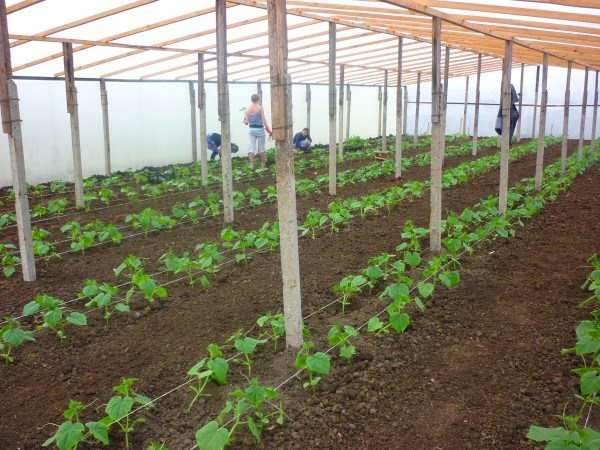
View
Today, the most suitable seed for a greenhouse cucumber are hybrids. They are considered the most productive. Moreover, they do not require special care for themselves, which would include such manipulations as pinching and pruning. There is also a large selection of seeds for the climatic conditions of germination.
Of the hybrid varieties, the best are "Marinda", "Ant", "Murashko", "Buyan", "Twixi", "Halley" and "Bidretta". Of the shade-tolerant long-fruited hybrids, the following varieties are considered the best: "Malachite", "Biryusa", "Stella", "Lada". All these plants are capable of producing crops without insect pollination (this is a self-pollinating subspecies), which is of great importance in growing them in a greenhouse where this is not possible. Otherwise, you will have to use a self-pollinator to get the ovary and, in the future, harvest.
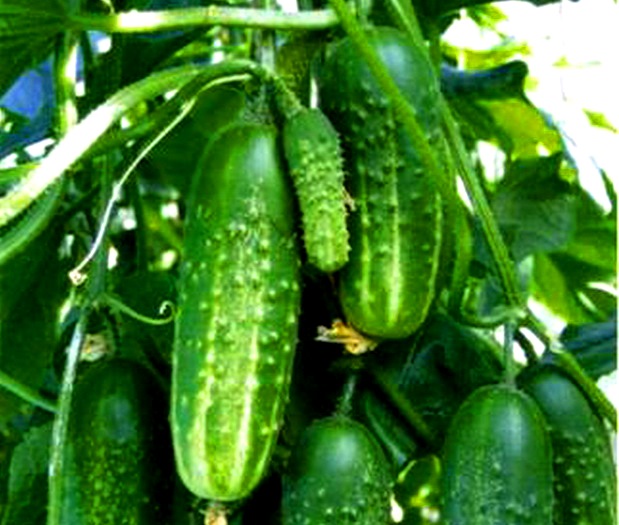
According to their characteristics and indicators, hybrids are significantly superior to ordinary varieties in terms of yield, therefore it is more preferable to select them for planting in a greenhouse.
By maturity
All cucumbers, according to the ripening criterion, are divided into very early (early ripening), mid-ripening and late-ripening varieties. Moreover, the sowing time for all varieties remains the same, but only the ripening period of the fruits differs.
By the timing of ripening, the choice of the type of plant is best carried out in terms of the use of cucumbers. In the case of cultivation for further conservation, it is best to opt for late-maturing species. It will be possible to start harvesting in the second half of the summer. Such greenhouse cucumbers are ideal for pickling, since it is at this time that the vegetable will accumulate the maximum amount of nutrients. For salting I will approach the following types: "Gypsy F1", "Mamen's favorite F1", "Barrel pickling F1", "Stash F1". The Dutch varieties Angelina F1, Hector F1, Dolomite F1 and Bettina F1 will grow well.
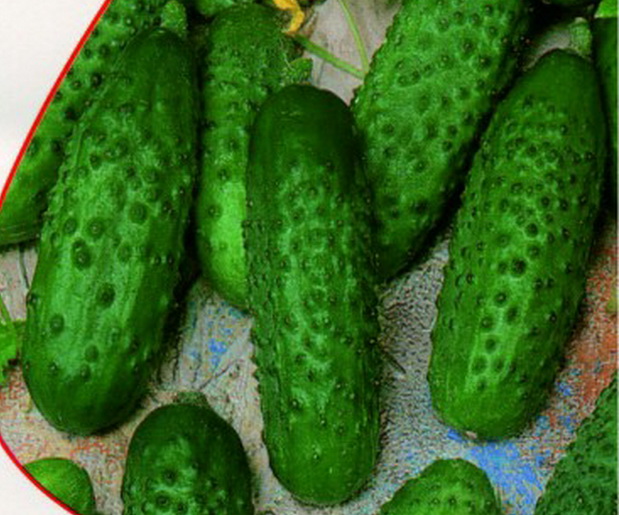
If you grow cucumbers in order to eat them fresh, then you need to use early ripening varieties for planting in a greenhouse. But remember that such plants have low yields. If you plan to use cucumbers only for cutting into salads, then it is better to plant mid-season varieties.
The best option would be to plant several different plant species at once in order to get a continuous harvest throughout the entire growing season.
By the way of pollination
This has already been discussed a little above. On any pack of seeds there will be an inscription about which variety it is - self-pollinated (parthenocarpic) or insect-pollinated. In the case of a plant growing in greenhouse it is best to give preference to self-pollinated species, i.e. those plants that form an ovary without additional pollination. Remember that if you decide to plant both parthenocarpic and insect pollinated species in a greenhouse, then mixing them is not recommended due to the fact that some self-pollinated varieties tolerate third-party pollination extremely negatively, which can lead to deformation of the fruit.

In addition to these three main criteria for the selection of seeds, not the last place is occupied by the resistance of cucumbers to various pests and diseases (oversporosis, powdery mildew, cucumber mosaic virus), as well as their yield. After all, it makes no sense to spend so much energy on growing plants that will give low yields. For all these characteristics, it is hybrids that are more profitable.
Growing seeds
Growing and planting seeds for a greenhouse occurs in the following ways:
- on a manure bed ("hot" or "warm" beds);
- on the compost bed.
Growing on a manure bed
This method is most suitable for the cold regions of the country. These beds begin to form in the greenhouse in the spring. This method allows for an earlier planting of cucumbers and an increase in future crop yields.
To create such beds, it is best to use fresh manure (preferably cow manure with a small addition of horse manure), which was collected in early spring. In this technology, manure acts first as "fuel" for the garden bed and plant, and then as additional feeding of plants in the greenhouse.
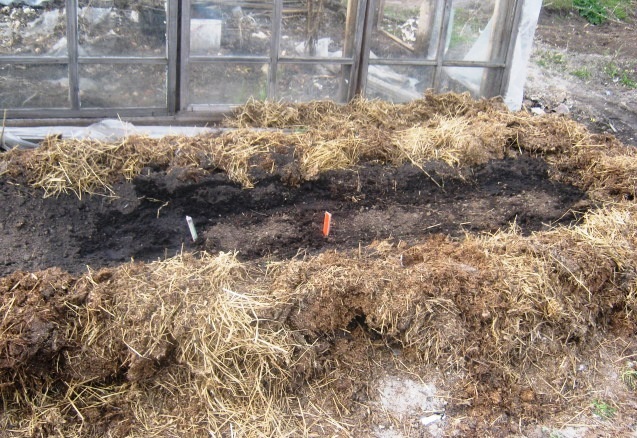
Manure bed technology:
- manure is placed on a high and elongated bed 1 m wide and of arbitrary length;
- a layer of fertile and loose soil is poured on top of the manure. Its thickness must be at least 25 cm;
- after these manipulations, the garden must be watered abundantly;
- the seeds are soaked and their germination is achieved (this stage can be skipped);
- after that, you can start sowing seeds. They are sown in such a way that four plants are located on each square meter;
- it is allowed to put two seeds in one hole in order to increase the percentage of germination. This is done in the case when the stage of soaking and germinating the seeds was skipped. But when both seeds germinate, the weakest seedling is cut at the root;
- planting seeds is carried out in the same way as planting in the open field;
- try to avoid thickening of the plantings;
- after the seeds have been planted, the bed should be covered with a light material that will be stretched over the previously installed arcs. In this way, you create a greenhouse in your greenhouse, which will serve as additional heating for the plants. The normal temperature regime for such a bed is within + 18-30 degrees.
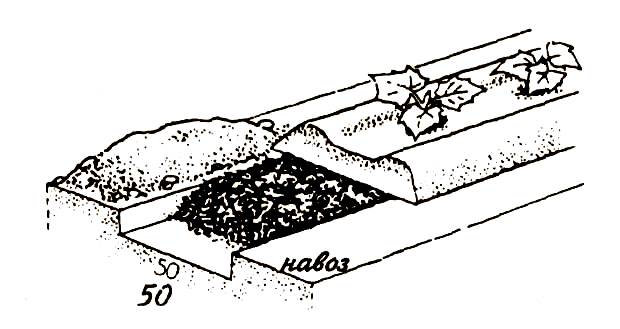
Diagram of the structure of the manure bed
If you did everything correctly, the temperature on the manure bed will be quite high - you can easily get burned. This temperature will last for about a month, and then it will start to drop. This effect is observed due to the fact that the decomposition process is activated in fresh manure under the ground. Thanks to this process, the first shoots appear within 3 or 5 days after planting the seeds.
It is necessary to constantly maintain the temperature in the garden, because inconsistent weather conditions can have a significant impact on germination. Increasing the temperature in the garden can cause the cucumbers to burn. To avoid this, thermometers are placed in the garden bed. To reduce the temperature in the ground, it is necessary to carry out regular ventilation of the greenhouse during the daytime.
Growing on a compost bed
In the case when it is impossible to get fresh manure, instead of it, to create manure beds, you can use last year's foliage, sawdust, tops, vegetable waste from the table, shavings and other organic materials, which are usually thrown into garden compost. It should be borne in mind that the compost heap will create a lower temperature inside the garden bed. Therefore, this method is used most often in warm regions of the country.
The presence of a large amount of green waste in the beds will help create a warmer microclimate. To achieve this effect, you can use special preparations that speed up the production of compost. As a result of their action, the temperature inside the garden will rise.
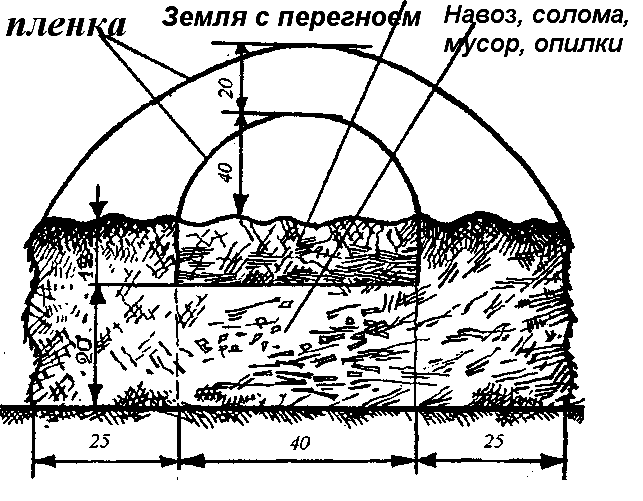
Diagram of the structure of the compost bed
On top of the compost, you need to put fertile soil 20 cm thick. In all other respects, the process of planting cucumber seeds in a compost bed is no different from planting in manure. The only difference is that it is allowed to plant seeds directly in peat tablets or glasses.
As you can see, in order to grow cucumbers in a greenhouse, you need to take into account quite a few factors: the variety, the method of pollination, as well as the climatic conditions of the place of growth. Compliance with these rules will help you get an excellent and bountiful harvest.
Video "Variety of varieties of cucumbers"
In this video, you can get acquainted in detail with the varieties of cucumbers, the seeds of which are perfect for growing in greenhouses.
